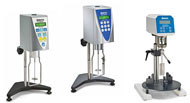Industrial viscometry

Viscosimetry also called viscosity measurements is department rheology - science of the study of phenomena of viscosity. The measure of internal friction is viscosity which is one of the most important properties of liquids and gases. To measure the viscosity of liquids are used devices called viscometers.
In industry viscometers are used among others in quality control in the refining process, in quality assurance systems of intermediates and final products in the petrochemical industry, in regulating the viscosity of fuel oil in power plants, as well as in printing process control by determining the viscosity of ink. They are used in the paper industry for processing of cellulose, and in the regulation of preparation of products and quality control in pharmaceutical and cosmetic industries and the food industry. There are several methods for measuring the viscosity, but considering a few fundamental factors can determine the optimal solution for most applications. First, determine the type of the liquid. Capillary viscometers are very simple and cheap solution for Newtonian fluids. But they are not very accurate. Due to the sensitivity of Newtonian fluid on changes in shear rate can be accurately measured using a rotational or vibration viscometer . In the case of liquids containing solid not use capillary and piston viscometers , as they are not resistant to the formation of deposits and clogging. Vibrating viscometers are usually constructed in such way that, during operation it is automatically cleaning. In the case of corrosive liquids can also specify anti-corrosion material which should cover the sensor. Although accuracy of the measurement is important aspect, often in the control systems in industrial applications measurement repeatability is more important. Good repeatability is characterized by all the presented methods. In most of the methods used in industrial processes the dynamic viscosity is measured, and in petrochemical installations many process measurements may require kinematic viscosity measurements, and this value often is considered the most important utility measurement used to determine the quality of the product. The solution is use of vibrating viscometers with tip in shape of a fork so that you can do additional measurement of the density, and thus the kinematic viscosity. In industrial applications, in control systems, the most popular are the capillary viscometers, but the response time of these sensors is quite long. Rotational and vibrating viscometers , which can be installed directly in process installation have much shorter response times and hence allow for a better control. The measuring range is an important factor when choosing the type of device. Capillary viscometers generally operate in a relatively narrow range and require the use of different capillary tubes in order to increase the measurement range. For rotational viscometers may be important use cylinders of different diameters. Vibrating methods have the largest measuring range, which results in that they are useful in applications in which different kinds of liquids are measured by the same viscometer or during mixing more fluids. The cost of the use of viscometers depends on the chosen method. Process capillary viscometers may require considerable implementation outlays. Especially when additional systems are required that allow you to maintain constant conditions of the measurement, ie, temperature, flow and pressure. In the case of rotating equipment implementation cost is not so high, but subsequent operating costs and regular maintenance can be considerable. Vibrating viscometers are usually the most expensive to install, but later their use is relatively cheap.
In practice, capillary viscometers found broadest application laboratory among them Oswald viscometer and faliiing sphere viscometer. There are also a lot of other methods that are used to measure the viscosity - bubble, rotary, ultrasonic and others viscometers. There are known bubble , rotational, ultrasonic and others viscometers – Engler Viscometer, Vogl-Ossag Viscometer, Höppler Viscometer. Application of Brookfield viscometers : the appointment of dynamic viscosity parameter. In laboratory studies and study an impact of organic and inorganic impurities on viscosity tetrafluoroborate N-butyl-4-methylpyridinium.In starch industry also uses a Brookfield Viscometer. In Characteristic Product Cards of different starch preparations quote often viscosity parameters determined by these devices. Temperature value during the test is equal to 25 ℃. Viscosity measurement is carried out using a rotational viscometer DV-II + and determination of flow curves for selected lubricating oils. The viscosity of lubricating oil depends on temperature and pressure. As the temperature increases the viscosity of the oil decreases. Depending measure of viscosity of the oil on the temperature is viscosity index. Better oils have higher values of this index. Viscosimetry is an important feature in the comprehensive assessment of the quality of road bitumen, used as a binder in mineral-asphalt mixtures for road construction. Knowledge of the parameter of the dynamic and kinematic viscosity is important for many industries in the current development of the technology. Wide choice of methods and measurement systems solutions offers a wide spectrum of ability to adapt to the individual needs of company's operations.
In laboratory studies and study an impact of organic and inorganic impurities on viscosity tetrafluoroborate N-butyl-4-methylpyridinium.In starch industry also uses a Brookfield Viscometer. In Characteristic Product Cards of different starch preparations quote often viscosity parameters determined by these devices. Temperature value during the test is equal to 25 ℃. Viscosity measurement is carried out using a rotational viscometer DV-II + and determination of flow curves for selected lubricating oils. The viscosity of lubricating oil depends on temperature and pressure. As the temperature increases the viscosity of the oil decreases. Depending measure of viscosity of the oil on the temperature is viscosity index. Better oils have higher values of this index. Viscosimetry is an important feature in the comprehensive assessment of the quality of road bitumen, used as a binder in mineral-asphalt mixtures for road construction. Knowledge of the parameter of the dynamic and kinematic viscosity is important for many industries in the current development of the technology. Wide choice of methods and measurement systems solutions offers a wide spectrum of ability to adapt to the individual needs of company's operations.
In practice, capillary viscometers found broadest application laboratory among them Oswald viscometer and faliiing sphere viscometer. There are also a lot of other methods that are used to measure the viscosity - bubble, rotary, ultrasonic and others viscometers. There are known bubble , rotational, ultrasonic and others viscometers – Engler Viscometer, Vogl-Ossag Viscometer, Höppler Viscometer. Application of Brookfield viscometers : the appointment of dynamic viscosity parameter.
 In laboratory studies and study an impact of organic and inorganic impurities on viscosity tetrafluoroborate N-butyl-4-methylpyridinium.In starch industry also uses a Brookfield Viscometer. In Characteristic Product Cards of different starch preparations quote often viscosity parameters determined by these devices. Temperature value during the test is equal to 25 ℃. Viscosity measurement is carried out using a rotational viscometer DV-II + and determination of flow curves for selected lubricating oils. The viscosity of lubricating oil depends on temperature and pressure. As the temperature increases the viscosity of the oil decreases. Depending measure of viscosity of the oil on the temperature is viscosity index. Better oils have higher values of this index. Viscosimetry is an important feature in the comprehensive assessment of the quality of road bitumen, used as a binder in mineral-asphalt mixtures for road construction. Knowledge of the parameter of the dynamic and kinematic viscosity is important for many industries in the current development of the technology. Wide choice of methods and measurement systems solutions offers a wide spectrum of ability to adapt to the individual needs of company's operations.
In laboratory studies and study an impact of organic and inorganic impurities on viscosity tetrafluoroborate N-butyl-4-methylpyridinium.In starch industry also uses a Brookfield Viscometer. In Characteristic Product Cards of different starch preparations quote often viscosity parameters determined by these devices. Temperature value during the test is equal to 25 ℃. Viscosity measurement is carried out using a rotational viscometer DV-II + and determination of flow curves for selected lubricating oils. The viscosity of lubricating oil depends on temperature and pressure. As the temperature increases the viscosity of the oil decreases. Depending measure of viscosity of the oil on the temperature is viscosity index. Better oils have higher values of this index. Viscosimetry is an important feature in the comprehensive assessment of the quality of road bitumen, used as a binder in mineral-asphalt mixtures for road construction. Knowledge of the parameter of the dynamic and kinematic viscosity is important for many industries in the current development of the technology. Wide choice of methods and measurement systems solutions offers a wide spectrum of ability to adapt to the individual needs of company's operations.








